
Cheerios and childhood – one of those up-in-the-morning start your kid’s day right, right? They’re gluten free, and they lower bloodstream cholesterol – almost like a health food. Except thanks to Monsanto, they’re not healthy, especially if you are a child. Cheerios breakfast cereal and a number of oat-based granolas and snack bars contain dangerous levels of glyphosate.
Over the past several years, the clinical and legal spotlight has been aimed at glyphosate, investigating how it poisons farm workers, landscape applicators, and maybe the general public through water and food exposure. Most recently, the Environmental Working Group (EWG) has done extensive research on glyphosate in foods that could affect human health during early childhood formative years. EWG is the organization that produces the yearly Dirty Dozen Produce list and the Clean Fifteen Produce list. Their findings on Cherios are not reassuring.

From the EWG study report: “The herbicide Roundup, produced by Bayer-Monsanto, was detected in all 21 oat-based cereal and snack products sampled in a new round of testing. All but four products contained levels of glyphosate higher than what EWG scientists consider protective for children’s health. The two highest levels of glyphosate were found in Honey Nut Cheerios Medley Crunch, with 833 parts per billion (or ppb), and Cheerios, with 729 ppb. The EWG children’s health benchmark is 160 ppb.
The EWG, along with nineteen food companies, first tried petitioning the EPA to get regulatory considerations. That process could drag on for years, and besides, the agency has been caught colluding with Monsanto to promote the claim that the chemical is safe. Instead, they are appealing directly to cereal manufacturers like General Mills and Quaker, petitioning them to source their oats from farmers who do not use glyphosate. So far, more than 236,000 people have signed a petition, and the EWG asks you to sign it as well – Get Glyphosate Out Of Our Food.

Two major reports released in late 2018 brought climate disruption to the forefront. For many people who previously had only passing concerns about the climate, the reports are unequivocal how climate disruption is a clear and present danger. The Fourth National Climate Assessment_2018 by the National Oceanographic & Atmospheric Administration, and the United Nations IPCC Special Report on Global Warming of 1.5 °C both reaffirm the science, and both reinforce each other’s conclusion that we have until 2030 to reverse global emissions and warming, before we face runaway climate collapse.
A single report might be easily ignored by deniers of climate trends and the scientific validity behind it, but two reports that present compelling data in detail are hard to dismiss. And now there is a third such report, released in May of this year, that presents a 2050 scenario “with dire implications, absent a fundamental change in human behaviour”.
The Melbourne, Australia based think tank, the Breakthrough National Centre for Climate Restoration, has concluded that the IPCC and the NOAA reports both are too optimistic. The report, Existential Climate Related Security Risks, projects that climate disruption “now represents a near- to mid-term existential threat to human civilization”, with a high liklihood of societal collapse as soon as 2050, if serious mitigation actions aren’t taken in the next decade. The new analysis is written by David Spratt, Breakthrough’s research director, and Ian Dunlop, a former senior executive of Royal Dutch Shell who previously chaired the Australian Coal Association. It is also endorsed by retired Admiral and former Chief of the Australian Defence Force, Chris Barrie.

NBC news explained how the Spratt-Dunlap analysis reached more dire conclusions. “The current climate crisis is larger and more complex than humans have ever dealt with before. Studies such as the UN IPCC report fail to account for the sheer complexity of Earth’s many interlinked geological processes. As such, they fail to adequately predict the scale of the potential consequences.”
The collapse scenario “begins with world governments ignoring the advice of scientists, resulting in a global temperature increase 5.4 F (3 C) by the year 2050. At that point, the world’s ice sheets vanish; brutal droughts kill many of the trees in the Amazon rainforest (removing one of the world’s largest carbon offsets); and the planet plunges into a feedback loop of ever-hotter, ever-deadlier conditions” – Civilization could crumble by 2050 if we don’t stop climate change now. Billions would suffer water scarcity, food production would suffer dramatically worldwide, and nation-states like the US and China would unravel.
Admiral Chris Barrie relates in the study’s introduction “This policy paper looks at the existential climate-related security risk through a scenario set thirty years into the future, painting a disturbing picture of the real possibility that human life on earth may be on the way to extinction, in the most horrible way. A doomsday future is not inevitable! But without immediate drastic action our prospects are poor. We must act collectively. We need strong, determined leadership in government, in business and in our communities to ensure a sustainable future for humankind – Can we think in new ways about the Existential Climate Risks?. The report states that the only way to avoid such a collapse is “akin in scale to the World War II emergency mobilization” focused on rapidly building out a zero-emissions industrial system – ‘Social Breakdown and Outright Chaos’: Civilization Headed for Collapse by 2050, New Climate Report Warns.
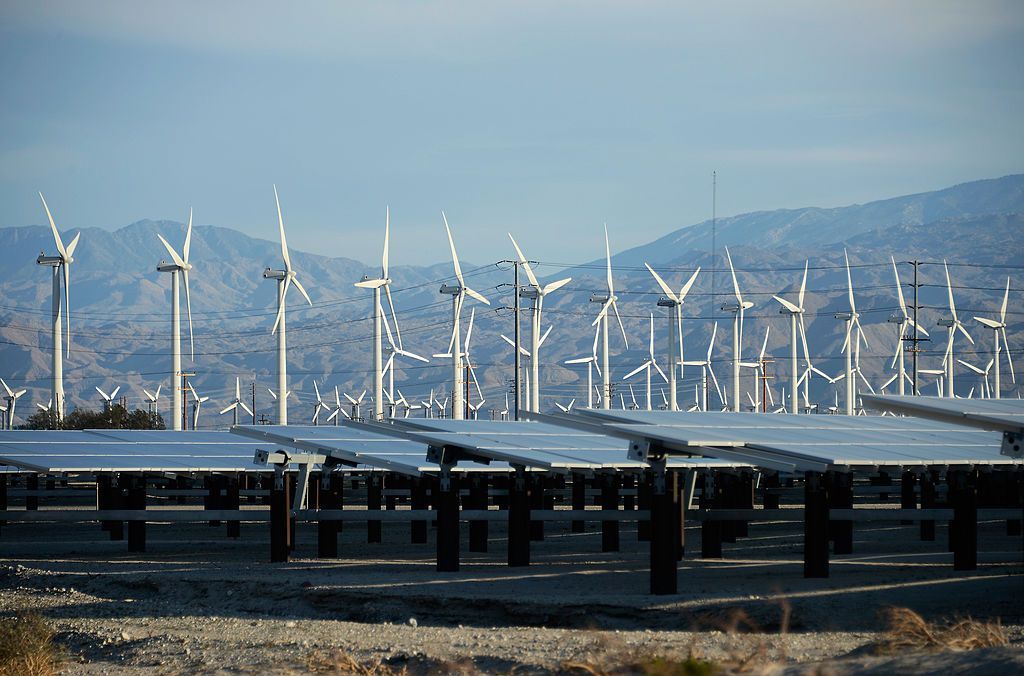
“Imagine a world where 85% of all electricity comes from renewable sources, there are over one billion electric vehicles on the road, and we are on track to preserve a livable climate for our children and future generations. The International Renewable Energy Agency (IRENA) reported this week that such a future is not merely possible by 2050, but thanks to plummeting prices in key clean energy technologies, the cost of saving the climate has dropped dramatically. According to IRENA, the most cost-effective strategy to achieve a ‘climate-safe future’ is an accelerated energy transition to renewables and energy efficiency coupled with electrification of key sectors like transportation.” – Joe Romm, Global economy would save up to $160 trillion by shifting to renewables, electric cars.
The choice is to pay for climate protection by rapidly transitioning to renewables and electrification of everything, or pay increasingly for climate disasters. The National Oceanographic & Atmospheric Administration (NOAA) cost figures for 2017 climate disasters was $306 billion, a record high. NOAA said that since 1980, the total costs for climate disasters has been $150 trillion – 2017 Weather and Climate Disasters Cost U.S. Record $306 Billion. By comparison, the IRENA report projects that over the next 30 years, a Renewable Energy Roadmap (REmap) scenario “would save the global economy up to $160 trillion cumulatively”. IRENA reports that “every dollar spent on energy transition would pay off up to seven times”. At the same time, the REmap would achieve more than 90% of emissions reductions needed to keep warming below 2 degrees Celsius, by reversing the emissions curve 70% – Global energy transformation: A roadmap to 2050 (2019 edition).
Of course, the transition to a renewable energy economy should have begun 30 years ago, as folks like Amory Lovins, Donella Meadows, M. King Hubbert, and James Hansen had championed. But since we are in the current bind we are, Yes! Magazine has described a three phase transition that can make great strides within ten years, and almost a complete transition by 2050, while simultaneously reducing atmospheric carbon with each passing year. The first phase takes on the easy stuff, like solar and wind power for electricity instead of coal, rooftop solar with battery storage, walking and bicycling and transit, and electric vehicles (EVs). Add to that things that hadn’t emerged at the time of the 2016 Yes! article, such as the rapid development of EVs as battery storage for utilities, as well as utility scale battery banks to replace peak load generation by natural gas. And a move to more organic agriculture could significantly reduce much the 20% of emissions from petro-chemical fertilizers and pesticides, while sequestering enormous amounts of atmospheric carbon in topsoil. For some reason, the article overlooks the even larger potential of tree planting to capture atmospheric carbon.
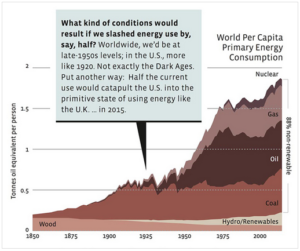
Phase two tackles the more difficult stuff, like electrifying heavy transport by truck and rail and transit, converting to sail-powered ocean ships, and deglobalization of manufacturing to reduce the need for shipping. There are significant challenges in the manufacturing sector, though much of it already runs on electricity. Considerable effort will be needed to replace fossil fuel feedstocks for plastics and other petrochemicals, such as the emerging bio-based plastics. Mining and metals smelting pretty much require fossil fuels, so a strategy may be to reduce their need by “cradle-to-cradle” reuse and recycling programs.
And phase three addresses the really hard stuff. The second most common building material is concrete, which requires the high heat of fossil fuels to cook the portland cement. To convert to production by concentrating solar thermal or solar-derived hydrogen would require completely redesigning the process. The most difficult aspect of eliminating fossil fuels from agriculture is in the realm of mechanized field traction – plowing, discing, combining. Abandoning huge industrial farms in favor of smaller, more labor intensive organic farms will likely meet with resistance unless labor and pay equity are guarantied. The use of rare earth minerals and high heat processing for electronics and communications is a knotty problem, for which the best solution might be to make very durable and readily repaired products. And finding a light weight, energy dense power source for air transport is barely on the drawing boards – 100% Renewable Energy: What We Can Do in 10 Years – Yes! Magazine.
A sobering take-away lesson from the Yes! article is, “One way or another, the energy transition will represent an enormous societal shift. During past shifts, there were winners and losers. In the current instance, if we don’t pay great attention to equity issues, it is entirely possible that only the rich will have access to renewable energy”.
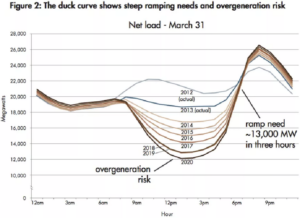
To achieve the practical goals listed in the Yes! article, a renewable energy future will need to electrify everything. The common perception from the coal electricity era has been that electricity is inherently dirty, and to be minimized. However, it’s possible, and it’s getting progressively more feasible to get electricity down to zero carbon through wind, solar, hydro, and geothermal (some falsely claim nuclear too – read the myth here – There is no such thing as a zero or near-zero-emission nuclear power plant). The same cannot yet be said of combustion fuels, even of biofuels that take an almost equivalent amount of fossil fuels to grow and process. Much of the research to electrify everything is focused on the electric grid – how to supply it with carbon free energy, and how to balance the ever-fluctuating solar and wind supply with the ever fluctuating user demand – as represented by the “duck curve energy demand cycle”. We won’t get into the details here, but the reading is fascinating at – The key to tackling climate change: electrify everything, and What Would the ‘Electrification of Everything’ Look Like in America?.

For anyone paying attention, and who takes the scientific data seriously, it’s understood that the surviveability of humans and up to 50% of other species is in peril. The threat is not just climate disruption. It’s just that the harsh and widespread impact of climate disruption is tangible in a way that tends to be convincing. Other not-so-obvious ways that threaten the planet’s livability are what Swedish environmental science professor, Johan Rockstrom, calls the Nine Planetary Boundaries. They include: lost biodiversity as species become extinct, deforestation and other land use changes, ocean acidification, freshwater depletion, and dumping of chemical, radioactive, and plastic pollutants into the environment, to name a few – Earth is halfway to being inhospitable to life – Planetary boundaries. The impact of these tend to be incremental and scatter-site, and not as apparent as extreme climate events until some cumulative threshold is passed, and disaster strikes. Even then, the cause and effect is often difficult to connect.
Pollution dumping as a breach of an Earth Boundary holds a unique place among the various boundaries. Chemicals, radioactivity, and plastics are all products of the energy sector, which for 150 years has been extracting non-renewable fossil and nuclear fuels from the Earth. The pollutants that accompany this extractive onslaught are the consequence of our ravenous energy appetite. And an unrestrained fossil energy appetite is the primary driver of transgressions against all the other Earth Boundaries – climate disruption from greenhouse gases, deforestation from energy extraction, ocean acidification from greenhouse gases, freshwater depletion from energy extraction and chemical pollutants, land and waterways pollution from synthetic farm chemicals, and more. It all starts with non-renewable energy extraction. That’s the underlying cause, and everything else is a consequence. Non-renewable energy is THE problem.

People and groups who have been confronting the range of issues we are discussing have usually grappled with one narrow aspect at a time, because that’s at a scale they can manage. But they often fail to see the forest for the trees – that energy is at the root of their local issue. Multiple groups attacking distinct angles of an issue can work well, as in “death by 100 cuts”, so long as they all view it in the context of non-renewable energy being the ultimate problem. Now, if this editor’s read of history is correct, mass protest groups first looked beyond a local issue and cited global fossil energy as the problem when First Nations People in both Canada and the U.S. tackled pipelines and tarsands mining. Tribes and coalitions such as Silent No More and Water Protectors said the solution to all energy justice issues was to “Keep it (fossil energy) in the ground”. If we don’t burn fossil fuels, we won’t suffer the consequences.
As a strategy, “keeping it in the ground” stops ecological and social damage on many fronts simultaneously. With no fossil fuel use, the land, water, and air, and vulnerable populations as well will all be protected – done! The idea is captivating, and has become a rallying cry. For more than a decade, analysts have run at least 40 different computer models to show that 80% or more of fossil fuel reserves must remain in the ground if we hope to regain a livable atmosphere. Bill McKibben explained that of the 2,795 gigatons of carbon in the proven coal and oil and gas reserves, all must remain untapped except for 565 gigatons to keep the planet below 2°C warming (and we now know that 1.5°C is the safe level) – Global Warming’s Terrifying New Math.
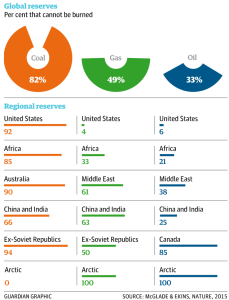
So here’s the conundrum. Stopping the social and ecological damage of fossil (and nuclear) energy is one half of the equation. By doing that, it should be noted that the equation’s other half will also stop most of modern society’s functions. In rough numbers, non-renewable energy currently supports: 95% of electricity supply, 95% of transportation fuels, 95% of building heating, 80% of food production from synthetic inputs, 75% of consumer products based on plastics (including the computer you’re reading this on), and 50% of building materials based on oil-derived adhesives, coatings and finishes. All this goes out the window with non-renewable energy. Obviously, to curtail society’s non-renewable energy use so drastically will require two alternative tactics: generation of non-fossil-derived materials and fuels, but even more so, adoption of more frugal lifestyles. Finding substitutes to completely replace the non-renewable inputs of modern society is a tall order, especially before the climate target dates at mid-century. For example, renewable electricity is a particularly daunting challenge – The Global Energy System Is Becoming More Electric, But Not Fast Enough, and At this rate, it’s going to take nearly 400 years to transform the energy system.
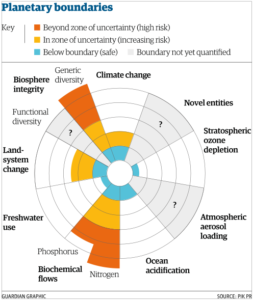
As far as is known, the other eight Earth Boundaries have no target dates like climate warming, other than “urgent”. According to the National Academy of Sciences, the human appropriation of net primary production (HANPP) of the Earth is above 25%, and trending to 30% by mid-century. HANPP measures the units of carbon per year expropriated by humans from biomass, including crops, timber, livestock forages, human caused fires, and conversion of forest to cropland or urbanization. The more taken by humans, the less available for other species – Global human appropriation of net primary production doubled in the 20th century. The Global Footprint Network noted that 1 August 2018 was this year’s Earth Overshoot Day, when humanity’s total annual demand on nature exceeded what Earth’s ecosystems can regenerate in that year – Earth Overshoot Day 2018 is August 1, the earliest date since readings done. And a report by twenty two scientist entitled the “Global Environment Outlook” from the United Nations Environmental Program (UNEP) noted that once 50-90% of an ecosystem is altered, it risks imminent collapse. On a global scale they indicated that 43% of the world’s terrestrial ecosystems have been converted to agriculture or urban use, and unless patterns of human consumption are greatly reduced, by 2025 half of the world’s land surface will have been altered. Lead author Anthony Barnosky warned “We want to stay away from that 50%” – Scientists: if we don’t act now we’re screwed.
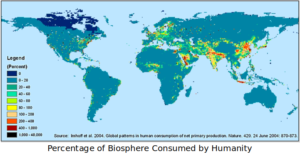
Whatever way you cut it, human impacts on the planet, climate and otherwise, are stressing the ecosphere to the limit. Curtailing fossil and nuclear energy is imperative to bring the Earth back from the brink, but will have far reaching implications for human societies. A look at climate disruption and coming to grips through some realistic scenarios is explored in this in-depth article – Real ambition on global warming: what it would look like. It generally applies to the other Earth Boundaries as well. Whatever scenario is preferred, it will need to entail a range of tactics, all pursued simultaneously, to reach zero carbon or better yet negative carbon. By our assessment, the following are the minimum key goals of any prescription to lower the fever of the planet.
-
Keep non-renewable fuels in the ground: More than 80% of fossil fuel reserves must remain in the ground if we hope to regain a livable atmosphere – Global Warming’s Terrifying New Math..
-
Invest in 100% renewable electricity: The annual U.S. $20billion subsidies of fossil fuels and the hundreds of $billions invested by global banks in fossil fuels must shift entirely to renewable energy – World’s Biggest Banks Are Driving Climate Change, Pumping Billions Into Extreme Fossil Fuels.
-
Electrify all end uses: With some exceptions like heavy transport and blast furnaces, applications of space heating, light transport, motor drive, and industrial boilers and process heating are prime targets for electrification – Enter the electrification of everything.
-
Enhance and utilize ecosystem services: Ecosystem services support humans, like carbon sequestration, pollination, and water purification. Compromised systems mean that human labor and technology must perform the functions at our expense – Ecosystem Services.
-
Drawdown CO2: Excess CO2 must be removed from the atmosphere to regulate the Earth’s temperatures at a safe level. Drawdown can be facilitated by a full range of solutions, both technical and natural – Drawdown Solutions.
-
Polluter pays: One way the rich get rich is by privatizing profits while socializing the costs, such as not paying to dump pollution, forcing society to either pay for clean-up or suffer illness. The Polluter Pays Principle is recognized by law, but not applied consistently nation to nation – What is the polluter pays principle?.
-
Forest protection and reforestation: Reforestation is the most effective “carbon negative” solution, whereas carbon capture and sequestration is expensive and unproven – Nature could suck up 21 percent of our greenhouse emissions (with a little help).
-
Indigenous Peoples’ Land Management: Indigenous land management conserves biodiversity, maintains ecosystems services, safeguards gifting cultures and traditional ways of life, and resists against deforestation and mineral, oil, and gas extraction – Indigenous Peoples’ Land Management.
-
Reduced meat diet: The UN Food and Agriculture Organization reported that 17.4% of greenhouse gases (GHG) are produced by livestock. Cattle ranching accounts for 80% of Amazon deforestation, and 65% of U.S. farm manure is from CAFOs – Without changing human diets, it’s impossible to halt global warming.
-
Frugal lifestyle at northern European consumption rates: The U.S. 5% of global population uses 25% of the world’s fossil fuels. Per capita emissions in the U.S. are three times as high as in Denmark. Frugality is pocketbook and planet friendly – Capital Accumulation and Opting Out of the Consumerist Machine.
-
Raise soil organic matter to 10%: Fertile soils have up to 10% carbon, but chemical farming reduces that to near 2%. Adding carbon back through no-till cover crops, perennial cropping, and biochar will sequester CO2 as well as recreate fertile soils and enable organic agriculture – Soil as Carbon Storehouse: New Weapon in Climate Fight?.
-
Educate girls: Women with more years of education have fewer and healthier children. This is one of the most powerful levers to cut emissions by curbing population growth – Educating Girls.
-
Population reduction to 2 billion humans: Per capita conservation of energy and resources can reduce climate emissions, but only if population doesn’t outpace frugality. Continued exponential population growth is a dead end on a finite planet – Too Many People, Too Much Consumption.
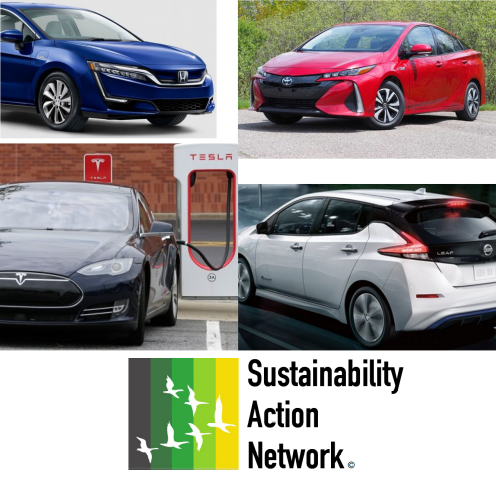
It’s National Drive Electric Week – September 8-16, 2018. The Sustainability Action Network is presenting the Lawrence Electric Vehicles Showcase on Saturday, 15 September, as one of 300 similar events around the country. It will take place from 1:00-4:00pm in The Merc Co+op parking lot, 901 Iowa St., Lawrence KS 66044.
Though not a panacea, electric vehicles (EVs) can significantly reduce the fossil energy use by cars, trucks, and buses. The U.S. transportation sector now produces more climate warming emissions than does the electric generation sector. Plug-in EVs produce no carbon tailpipe emissions when charged with renewable energy. And because an EV is lighter than a fossil fueled car, and electric motors are more energy efficient than internal combustion engines, an EV has a lower carbon footprint in general, even when charged by coal fired electricity. EVs get 100mpg equivalent or better, and the driving range is from 100 miles to 315 miles.
It will be an exciting lineup of EVs at the Lawrence Showcase:
- 3 Nissan LEAFs
- 5 Tesla Model S, 2 Tesla Model X, 2 Tesla Model 3
- 1 Toyota Prius Prime
- 2 Chevrolet Bolts, 2 Chevrolet Volts
- 1 Honda Clarity
- 5 electric bicycles
You will be able to see these vehicles in the Merc Co+op parking lot, talk with their owners, and learn the advantages of driving an EV. We’ll have electric bicycles too. Electric cars are a great improvement over fossil cars, but E-bicycles are the gold standard, using but a fraction of a percent of energy used by any motor vehicle. A 4000lb car requires up to 60 Kilowatts (60,000 Watts) of electricity per hour, and consumes about ten times the electricity used by a home. A bicyclist pedaling uses only 150 Watts to go 20mph, and slightly more if electric pedal assisted.
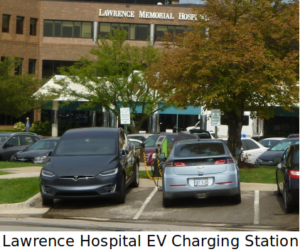
Two City Commissioners will be at the showcase with their electric vehicles. Also, a Proclamation by the Lawrence Mayor for Drive Electric Day will be read at the Lawrence City Commission meeting at City hall, on Tuesday, 11 September, at 5:45pm. Furthermore, at the same meeting, the Commission will approve an electric vehicle charging station at 733 New Hampshire St., the first one downtown. This will be the sixth in Lawrence (The Merc Co+op will install the seventh soon!).
We’re grateful for our co-sponsors, the Sierra Club/Wakarusa Group and The Merc Co+op, and support from the Kansas Cycling Association. This local event is one of 300 community events being celebrated across the country during National Drive Electric Week. Check our event page at – Lawrence Electric Vehicle Showcase, and Lawrence Electric Vehicle Showcase – Facebook.

The 5 July 2018 blameworthy yet unrepentant fall from grace by EPA head, Scott Pruitt, had the typical staging and theatrics of any of the president’s* firings or resignations. Taking a page from his boss’ playbook, Pruitt had seemed not to care about appearances of corruption, having grabbed the gold in cavalier ways – an oil lobbyist’s condo for $50 a night, $43,000 for a soundproof phone booth in his office, $ hundreds of thousands for first class and chartered flights, a $3 million 20-member security detail, using EPA resources trying to get his wife a Chick-fil-A franchise, and more. When he resigned amid so many scandals, ethics violations, extravagant spending schemes, and lawsuits, he played the martyr when saying “The unrelenting attacks on me are unprecedented and have taken a sizable toll” – and the saint by telling the president* “My desire in service to you has always been to bless you . . . I believe you are serving as President today because of God’s providence. I believe that same providence brought me into your service”. Such trauma-drama; you just can’t make this stuff up.
Pruitt, who was described by Richard Wolffe (and many others) as “The Worst EPA Administrator of All Time”, is gone – Goodbye to the worst EPA administrator of all time. But it can’t be overlooked that Pruit’s departure is just one spin of the “corporate-official revolving door syndrome”. Whether an elected or appointed official, or a corporate lobbyist or director, they don’t care which role they play, because they are all corporatists working for the good of corporations. And they don’t care if their government tenure is long or short, so long as they do maximum damage to society’s protections. Their purpose, and their only purpose, is to grease their own skids while eliminating any semblance of corporate regulation or restrictions. Pruitt is gone, but his damage is considerable. Said Ken Cook of the Environmental Working Group “Sadly, the ideological fervor with which Pruitt pursued the destruction of environmental regulations and the agency itself live on”. Let me count just some of the ways.
- Dismantling the EPA, slashing staff and advisory panels, spying on employees
- Rolling back 25 EPA rules that protected the air, water, and climate
- Evaluating regulations based on cost in dollars rather than cost to the environment
- Minimizing restrictions required by the Clean Power Plan
- Reversing the ban for all food crop uses of chlorpyrifos
- Gutting the Waters of the United States rule so downstream impacts are exempt
More details can be found at – Scott Pruitt is out but his impact on the environment will be felt for years, EPA rollbacks already touching Americans’ lives, and 76 Environmental Rules on the Way Out Under Trump. With Pruitt gone, one would hope for reinstatement of some of these rules, or at least a breather from the onslaught. Unfortunately, there are always more shock troops waiting in the wings.
Andrew Wheeler, Pruitt’s replacement, was a lobbyist for Murray Energy, the largest coal company in the U.S., he served as a vice president of the Washington Coal Club industry association, and he lobbied the Department of the Interior to open Bears Ears National Monument to uranium mining. He also had been Chief of Staff for Senator James Inhofe (R-OK), described by some as the loudest and dumbest climate denier in the Senate. Environmentalists are duly concerned that Wheeler will follow the same ideology as Pruitt, but be much more effective. He is a Washington insider, quite familiar with navigating the network of the Federal government. An NPR commentator, Scott Segal, said “He is somebody who has been preparing for a position of responsibility like this really for all of his life”. Bob Deans of the Natural Resources Defense Council said of Wheeler “Going from a train wreck to a house on fire doesn’t give us comfort”. Read more at – Who Is Andrew Wheeler? Key Details On Trump’s Pick To Replace Scott Pruitt, and Andrew Wheeler: ‘point man for Trump’ focused on undoing Obama’s EPA agenda. Be careful what you wish for.
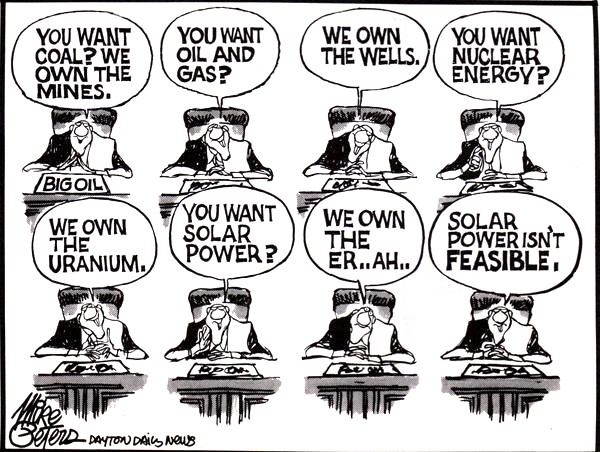
On Thursday, 28 June 2018, at 6:00pm, the Kansas Corporation Commission (KCC) scheduled a hearing in Wichita on a combined rate increase request by Westar Energy. The hearing location is Lowe Auditorium, Wichita State University, 5015 East 29th St. N, Wichita KS 67220. The case includes a penalty rate to be charged only on customers with rooftop solar installed after 28 October 2015. Anyone interested in widespread grassroots solar (distributed generation or DG) as opposed to centrally controlled Big Utility solar, is advised to attend. Here is the KCC docket number and link – docket 18-WSEE-328-RTS, but we apologize that the KCC’s web pages are chronically broken, denying the public timely information. However, the KCC Public Comment page does work, so you may submit your comments here – Public Comment_Westar Rate Hike_18-WSEE-328-RTS.

One of their members of the Flint Hills Renewable Energy and Efficiency Co-op (FHREEC) has written a white paper about the implications of the rate case, entitled “Westar’s Rate Request: Why it is Bad for Ratepayers, Kansans, and Westar Themselves”. Here are excerpts:
“Modern grid-tied rooftop solar is a cheap, simple, safe, and an efficient way to generate power. With a do-it-yourself installation (like FHREEC does), a home-owner can double their investment in about 7 years. Systems are modular, expandable, and can be installed safely, with a connection to the Westar power grid for back-up supply or excess power sales. Electricity will flow back into the grid whenever the building’s collectors are generating more electricity than is being used by the occupants. This is called ‘distributed generation’ (or DG), and Westar Energy could choose to incorporate it into their plans for meeting consumer demand, as so many utility companies around the world are doing. Instead they are fighting it.
“Westar proposes to impose a different billing system on customers who generate some of their own electricity, called the ‘demand plan’, a relic of old metering technology invented prior to ‘time-of-use’ meters. Westar has not been transparent about the details of this plan. From what we can tell, customers who generate any of their own electricity would be charged a fixed base fee, plus a volumetric fee, plus a demand fee. The demand fee would be calculated based on the highest 15-min draw placed on the system in a given month (not the average, not the median, but the highest). The solar customer could be charged as much as $70-90 extra on their bill that month.

“Evidence indicates that this rate case is a punitive measure intentionally designed to kill the financial benefits of rooftop solar. Westar views any generation not on their side of the meter as a threat. Westar places solar in the category of ‘risks that adversely affect their bottom line’, admitting that significant advancement in technology and decreased hardware costs make solar generation competitive. They also state that viable battery backups for solar systems are coming on the market, and when advancements in batteries catch up to advancements in panels, it will be easy to leave the grid entirely.
“Current Westar policies intentionally keep consumers in the dark, but they could be more transparent regarding rate structure for DG customers. On www.westarenergy.com, there are examples of how customers are billed under standard rate plans, but no adequate explanation of how DG solar residential rates are currently calculated, nor how the proposed new DG residential rates would be calculated. Generating renewable electricity may be protected by federal laws in the Public Utility Regulatory Policies Act (PURPA). We question whether Westar has any legal basis for punitive action aimed at customers who install a few panels to lower purchased consumption.

“Since DG customers buy less electricity, they are accused of not ‘paying their fair share’, of using the grid as a ‘battery’, or in the wording of the docket, as an energy ‘backup’. Almost by definition, the grid is a backup – for keeping warm or cool or well-lit when we can’t put on an extra sweater, cool off in the shade, or read by the light of the sun. We only purchase energy when we must, but Westar’s wording seems to imply that fixed, high energy consumption is something they have a right to expect of the consumer. By the same logic, would they penalize someone who chooses to conserve energy by drying their clothes on a clothesline instead of using a clothes dryer, and force them into a different rate class? Modernizing the grid is a viable solution to incorporating DG, as has been done elsewhere (see: http://www.raponline.org/document/download/id/7956publication “Teaching the Duck to Fly”).
“Technology exists that would help energy-conscious consumers and Westar work together to combat peak demand problems. Peak demand periods are when utility companies struggle to meet demand, and rooftop solar helps the grid, rather than harms it, by producing peak load power. Because peak load power is worth more than base load power, DG customers should be compensated rather than penalized. The proposed rate structure is counterproductive to Westar’s goal of mitigating peak demand issues. In the near future, many consumers will simply opt to be off-grid entirely unless they are provided with economic incentives to remain faithful to it. Stifling advancements in technology never works in the long term. Corporations that cling to antiquated policies and procedures fail. It is time to work together toward solutions that are forward-looking, fair to consumers who care about controlling their energy costs, and promote the long-term financial viability of Westar Energy.” You may submit your comments to the KCC here – Public Comment_Westar Rate Hike_18-WSEE-328-RTS.
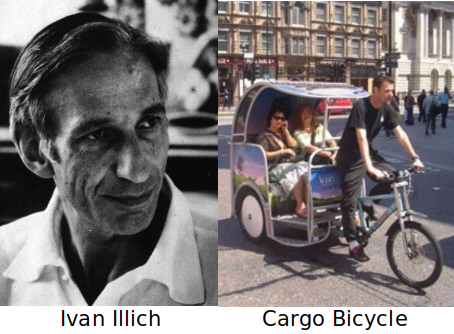
Considered one of the most important social philosophers of the 20th Century, Ivan Illich proposed in his 1974 book, Tools For Conviviality, a retooling of society itself. Tools for Illich were not just mechanical devices, but also institutions, industrial productivity, transportation systems, and information sharing. He defined convivial tools as those most accessible by each person, the least controlled by others, and without restricting equal use by others. His 1973 book, Energy And Equity, posited that “Participatory democracy postulates low-energy technology. Only participatory democracy creates the conditions for rational technology.” Illich advocated for a scaling back of our energy intensive consumer society long before most recognized how such a society results in ecological collapse and climate disruption. He proposed simpler autonomous tools for the sake of equity, justice, and the health of our souls. In this context, the focus is bicycles.
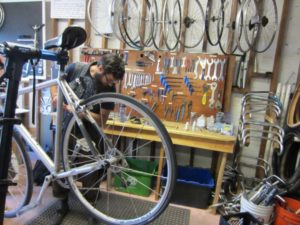
The bicycle as the most convivial of tools
The motor car fails as a convivial tool, as it is dependent on centralized production far beyond the capability of individuals or a cottage industry, and its use severely restricts those without an automobile of freely using any form of non-motorized mobility. Anywhere that they were introduced to non-industrialized communities, automobiles expropriated convivial public spaces by virtue of their size and speed, the lanes, roads, village squares, and market places that previously had been the equally shared commons. In the words of Ivan Illich, “The present world is divided into those who do not have enough and those who have more than enough, those who are pushed off the road by cars and those who drive them” – Tools for Conviviality: Illich.

In describing the superior efficiency of human powered mobility Illich wrote “Man on his feet is thermodynamically more efficient than any motorized vehicle and most animals. Man on a bicycle can go three or four times faster than the pedestrian, but uses five times less energy in the process. He carries one gram of his weight over a kilometer of flat road at an expense of only 0.15 calories. The bicycle is the perfect transducer to match man’s metabolic energy to the impedance of locomotion. Equipped with this tool, man outstrips the efficiency of not only all machines but all other animals as well”. He goes on to say “The invention of the ball-bearing made possible the bicycle, allowing the wheel to become useful for self-powered mobility. When combined with the tangent-spoked wheel and the pneumatic tire, the ball-bearing signaled a revolution, a true crisis, a true political choice . . between more freedom in equity, or more speed . . two new types of locomotion, respectively symbolized by the bicycle and the car” – Self-Powered Mobility: Energy and Equity; from Energy and Equity: Illich.
The envelope please: equity or speed?
It’s apparent everywhere that humans have a preference for speed, usually without realizing the implication for curtailing equity. Speed gives a unique pleasure, and a thrill like no other. But society’s choice of speed also received no small boost from sales marketing by the merchants of steel and petroleum. Simultaneously, public officials wishing to curry favor from the auto-oil crowd chose to spend the lion’s share budgeted for motorways, which severely constrained funding for bikeways. This scenario played out virtually everywhere, subsidized by Federal highway money, the epitome being the Interstate Highway System begun in the 1950’s.
When Davis CA and a few other cities like Boulder, Eugene, Madison, and Palo Alto tried to shift the emphasis toward separated bikeways in the 1960’s, a small, highly vocal, yet misguided group of bicyclists actually fought it, and delayed protected bikeways for decades. With the motto “Same Roads. Same Rules. Same Rights”, the so-called “vehicular cyclists” argued for access to the same pavement, rather than equal access to safety by cyclists of all ages and skill levels. Being only 6% of potential bicyclists, the message of vehicular cyclists would not have been so influential, except that it played into the hands of traffic engineers who made it their excuse to spend nothing on bikeways – One Surprising Reason the U.S. Lags Behind the World on Bikeways.
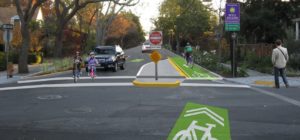
This issue of equity is not about access to a bicycle, which nearly anyone can have. The issue is access to a roadway safe from speeding motor vehicles. Today, it’s become clear that equity between bicycles and motor vehicles means parity of speed – that of bicycle velocity, or 15 mph. This makes it safe for everyone, whether they are people who walk, people who pedal, or people who drive. At 15 mph, everyone is visible, everyone is aware, and everyone can safely share the same space convivially. This was Ivan Illich’s prescription for convivial transportation, and it is the core design principle of Dutch “woonerfs”, which translates as “living street”. In the U.S., the concept is called “neighborhood greenways”, or “bike-walk streets”, or “bicycle boulevards” – Bicycle Boulevard images.

A recent report by the University of California Merced and published in Agronomy projects that climate disruption will have huge impacts on our food supply of California almonds, pistachios, oranges, apricots, nectarines and prunes, more than a third of our vegetables, including artichokes, broccoli, spinach and carrots and other food crops. Climate related impacts include the following: fluctuation and extremes of rainfall and floods, less Sierra snowpack resulting in less irrigation, Summer heat waves, greater susceptibility to disease, fewer Winter chilling days required to break seed dormancy, and fewer bees to pollinate crops.
Shorter chill seasons will make vast areas no longer suitable for chestnuts, pecans, apricots, kiwis, apples, cherries and pears. Severe heat waves will reduce yields of wine grapes, strawberries and walnuts. With lower bee populations, pollination will be compromised for almonds, apples, avocados, cashews, chestnuts, citrus, pears, and many vegetables and small fruits including grapes and strawberries. The report states that “By the end of this century, the shrinking winter chill period will reduce the acreage of the Central Valley suitable for chestnut, pecan and quince by 22%, and for apricot, peach, nectarine and walnut by more than half. By 2000, only 4% of the Central Valley was suitable for apples, cherries and pears, but none of that will be left by 2060 under almost any climate change scenario” – You can kiss much of California’s agriculture goodbye because of climate change..

A related report by the United Nations Commission on Trade and Development (UNCTAD) titled “Wake Up Before It’s Too Late” gave warning five years ago about the importance of working simultaneously on climate disruption, food security, and agriculture. The report primarily addresses how to feed the world through organic agriculture. But in so doing, by definition, fossil fuels are eliminated from production and use in fertilizers, pesticides and herbicides. As states the report, “This implies a rapid and significant shift from conventional, monoculture-based and high-external-input-dependent industrial production toward a mosaics of sustainable, regenerative production systems that also considerably improve the productivity of small-scale farmers”. With drastically decreased or eliminated fossil fuel use, there will be multiple benefits for the climate, the land, and the people: increased soil carbon content, lower greenhouse gas emissions, more extensive agroforestry and uptake of CO2, greater use of organic fertilizer in a closed nutrient cycle, cleaner streams and groundwater, and healthier and more self-reliant communities. The take home message is that “Organic and small-scale farming is the answer for feeding the world”. Learn more at – Urgent agricultural message from United Nations: Wake up before it’s too late.

A lecture by Rev. Michael Dowd:
Ecology Must Be the Heart of Theology
Friday, 18 May 2018, 7:00-8:30pm
Science and religion are not enemies; indeed they must work together if humanity is to survive the 21st century. Given our impact on Earth’s climate, the seas and other species, humanity is facing “the Great Reckoning” that can also be “the Great Homecoming,” as our prodigal species comes home to reality.
This presentation focuses on points of agreement held in common by tens of millions of religious and non-religious people across the globe. It will inspire and encourage you in the face of changing climate and other environmental and societal challenges.
Sustainability Action Network seeks to facilitate discourse that leads to Action towards an ecologically sustainable Earth. Michael Dowd brings a unique and compelling perspective into issues of faith, science and our future.
Friday May 18 7:00- 8:30PM
Wakarusa Wetlands Discovery Center
1365 N 1250 Rd, Lawrence, KS 66046-9618
Tickets available at: https://ecologyandtheology.brownpapertickets.com
Ecology+Theology
A science-based, deep-time big picture is vital for staying sane and sober in chaotic and contracting times. An evidential “dark optimism” can help us accept what is inevitable, avoid what is futile, and be a blessing to friends, family, and neighbors in a difficult and uncertain world.
The techno-fetish religion of growth everlasting was never sustainable. We tolerated it is because religion has been asleep at the wheel for centuries owing to idolatry of the written word, idolatry of the otherworldly, and idolatry of beliefs.
Anthropocentrism led us to defile primary reality — the climate, forests, soils, seas, and life upon which we depend. And now we are in the early stages of the Great Reckoning. The good news is that this may also be the Great Homecoming — the prodigal species coming home to Reality. By shifting from human-centered to life-centered measures of progress and success we can, once again, become integral members of the community of life.
By honoring the evolutionary significance of religion and the religious significance of science, we can experience a deep and profound love of life, trust in death, and passion for posterity. At the intersection of science, inspiration, and sustainability we find that ‘reality is divine’ and ‘ecology must be the heart of theology.’ Such a pro-future sacred realism clarifies our predicament and our way forward. MD
Rev. Michael Dowd is a bestselling eco-theologian and pro-science, pro-future ‘evangelist’ whose work has been featured in The New York Times, LA Times, Wall Street Journal, Washington Post, Newsweek, Discover, and on television nationally.
His book, Thank God for Evolution, was endorsed by 6 Nobel Prize-winning scientists, noted skeptics, and by religious leaders across the spectrum. Michael has delivered two TEDx talks, a program at the United Nations, and he and his wife, science writer and climate activist, Connie Barlow, have spoken to some 2,500 groups across North America since 2002.
He has also conducted an online conversation series: “The Future Is Calling Us to Greatness. Rev. Dowd’s entire body of “deep sustainability” text, audio, and video resources are accessible here and here. http://thegreatstory.org/new.html














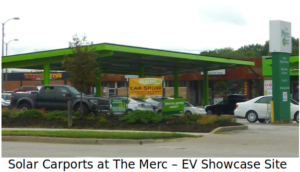
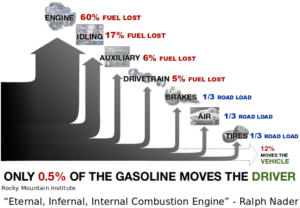



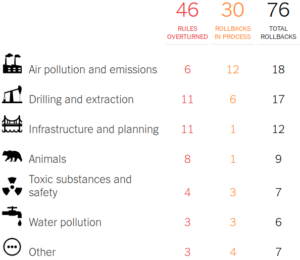











Recent Comments